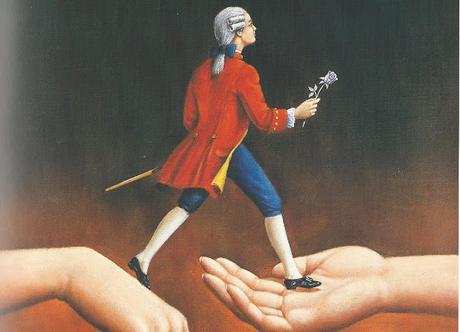by Paul J. Pelkonen

Detail from Rafal Olbinski's poster for the Opera Pacific's production of Der Rosenkavalier.
Art © Rafal Olbinski Estate and Opera Pacific
In some ways, the plot of Rosenkavalier is a follow-up to The Marriage of Figaro. The relationship between the Countess Almaviva and Cherubino in that opera is here replaced by the love affair between the Marschallin (the Princess Maria Therese) and Octavian, a 17-year-old nobleman with a ready sword and a quicksilver, passionate nature. Like Cherubino, the Octavian is played by a mezzo-soprano, and the character occasionally cross-dresses to avoid getting caught in the Marschallin's bed-chamber in Act I.
Complicating matters is Baron Ochs, the Marschallin's country cousin. At the start of the opera he is engaged to Sophie von Faninal, the 15-year-old daughter of a nouveau riche family. Octavian is recruited by the Marschallin to bring Sophie the Silver Rose, a symbol of engagement and the source of the opera's title. At the engagement, Sophie discovers what Octavian already knows: that Ochs is a bloviating, priapic idiot given to sexual harassment and a courtship style that eerily resembles the boasts of one Donald J. Trump. In the last act, Octavian sets up the Baron to be humiliated in front of Sophie's father, who has him run out of Vienna.
The final scene deals with the Marschallin's successful attempt to pass her lover on to his future wife, the beautiful (and even more silvery-voiced) Sophie. This happens in a great final trio between the two sopranos and the mezzo, in which the noble Marschallin lets her young lover get on with his life. The opera's close is just as enchanting, a duet for Octavian and Sophie as the Marschallin exits with Faninal, granting him the social privilege he craves with a ride in her carriage.
Written in the 20th century and set in the 18th, the magnificent score of Rosenkavalier centers on a 19th century musical idiom: the waltz. Waltzes are woven throughout the score, perfectly matching the energy of the comic goings on as well as the bittersweet nostalgia surrounding the Marschallin's relationship with Octavian. The score features some of Strauss' best orchestral jokes: the use of braying horns in the Act I Prelude, the Elektra chords that roar forth when Octavian pinks Ochs in an Act II swordfight and the use of an excruciating minor second (sung by "three noble orphans" as they chase Ochs off the stage in Act III.) It is an absolute masterpiece.
Recording Recommendations:
Der Rosenkavalier has a rich recorded history, with trios of singers teaming up to form the opera's famous love triangle. At four hours in length, any recording of this opera is an investment, and here's a guide to the best that are out there.
Philharmonia Orchestra cond. Herbert von Karajan (EMI/WBC 1957)
The classic, with Elisabeth Schwarzkopf and the young Christa Ludwig as the most elegant Countess and Octavian on disc. This has been a benchmark recording in the catalog for over sixty years. Make sure you get the stereo version and not the mono demanded by La Schwarzkopf.
Vienna Philharmonic cond. Herbert von Karajan (DG, 1981)
This is a classic live recording made at the Salzburg Festival in 1980. The Vienna Philharmonic plays magnificently, and Anna Tomowa-Sintow is radiant as the Marschallin. The recently deceased bass Kurt Moll is a very funny Ochs. There are standard stage cuts.
Dresden Staatskapelle cond. Bernard Haitink (EMI/WBC 1991) This EMI recording featuresa marvelous trio of leading ladies. Kiri Te Kanawa shows why she was the definitive Marschallin of her generation, and Anne-Sofie von Otter is a disarming, mannish Octavian. Kurt Rydl's Viennese accent makes him a marvelous Baron Ochs.

